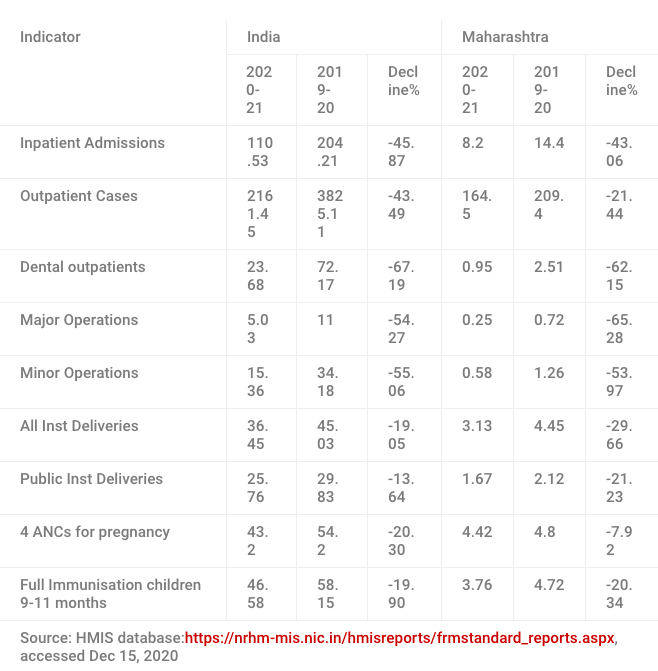Covid-19 Impact: Huge Decline in People Accessing Health Services

The impact of Covid-19 in our lives is wide-ranging–loss of livelihoods and incomes, forced migration, increased unemployment, disruption of the education system, reduced access to routine healthcare services, interrupted work and home environments and restrictions on travel, meetings, leisure activities and visits to friends and relatives.
There has been a transformation in our life spaces, social interface, cultural happenstances, economic exchanges and political engagements. We are now mostly confined within the four walls of our homes. We buy food and other necessities through online grocers and retailers instead of street corner vendors and the local baniya. We don’t go to cinemas and theatre as we watch films, drama and other entertainment programmes via OTT platforms. We are unable to participate in street protests and demonstrations and do so via social media. And of course, we have stopped face to face interactions with colleagues, friends and relatives and meet them via Zoom and video calls. Life has come full circle.
Drastic Effect on Healthcare
While we struggle to cope with all these changes, our access to healthcare, which is sometimes also a matter of life and death and agony and pain, has been drastically affected. Tuberculosis patients are not getting their medicines on time, cancer patients are unable to travel for chemotherapy or radiation, patients suffering from heart attacks and strokes can’t get timely access to hospitals and those experiencing mental breakdowns and involved in accidents can’t get the needed care. These are all life-threatening situations and with some luck, they may find access via the emergency care route. However, routine ailments have seen drastic declines in access and use.
Inpatient admissions (excluding deliveries) witnessed a fall of as much as 45%. In the case of outpatient care too at the national level, the decline in access was over 40%, with Maharashtra doing a little better.
The Health Management Information System data of the Ministry of Health publishes monthly statistics, mainly for Reproductive and Child Health and related programmes. Post-Covid, they have been able to make data available only for the first quarter of 2020-21, that is April to June 2020. When we compare this for the same period in 2019, we find huge declines in the number of people who are able to access key health services.
In Table 1 are listed some important indicators of public health facility access and use such as inpatient admissions, OPD cases, immunisation, antenatal care, etc. for India. Maharashtra is the worst-affected state. For each of these indicators, there are huge declines at both the all-India level, as well as in Maharashtra. Inpatient admissions (excluding deliveries) witnessed a fall of as much as 45%. One assumes that 2020-21 data includes hospitalisation for Covid-19 cases and if we were to exclude these, then the decline would be even larger. In case of outpatient care too at the national level, the decline in access was over 40%, with Maharashtra doing a little better, with a decline of one-fifth.
States with the largest declines like Maharashtra are also states with a large private health sector and the latter used the Covid pandemic to increase their charges substantially so that their profits remained unaffected.
In case of dental care and major operations, the declines were up to two-thirds and even minor operations saw a drop of over 50%. In case of deliveries, antenatal care and immunisation of children, the declines were around one-fifth, indicating that primary level healthcare was less affected by Covid-19. Of course, the period we are looking at is that of the stringent lockdown phase. One assumes that data for the subsequent quarters has shown an improvement.
Precipitous Decline
Table 1: Key Health Access Indicators during Q1 April-June 2019-20 and 2020-21 in Public Health Facilities (figures in lakhs)

What we learn from this is that the public health system was not robust enough to withstand the pressure of a pandemic of unparalleled virulence. This is largely because of the low investment by governments on healthcare and grossly inadequate budgets allocated for the sector at both the national and state levels. This contributes to the huge deficit of human resources, especially of doctors and specialists and gross shortages of equipment and supplies critical for the smooth and effective functioning of the public health system.
Robust States Also Affected
Even states which have more robust primary healthcare systems such as Sikkim, Mizoram, Goa, Himachal, Jammu and Kashmir and Kerala were impacted, but to a lesser extent, and hence they were better placed to cope with both the Covid crises as well as care for non-Covid ailments.
The public health system was not robust enough to withstand the pressure of a pandemic of unparalleled virulence. This is largely because of the low investment by governments on healthcare and grossly inadequate budgets allocated for the sector at both the national and state levels.
In sharp contrast, states with the largest declines like Maharashtra are also states with a large private health sector and the latter used the Covid pandemic to increase their charges substantially so that their profits remained unaffected.
So the message is clear–healthcare needs to be recognised as a public good and receive adequate budgetary allocations. To begin with, at least 2.5% of the GDP, which our National Health Policy mandates should be given. This will wipe out the prevailing deficits in the public health system so that people don’t suffer disruptions in its access when a Covid-type crisis hit us.
(Ravi Duggal is a health budgetary activist. The views expressed are personal.)
Originally Published in The Leaflet
Get the latest reports & analysis with people's perspective on Protests, movements & deep analytical videos, discussions of the current affairs in your Telegram app. Subscribe to NewsClick's Telegram channel & get Real-Time updates on stories, as they get published on our website.














